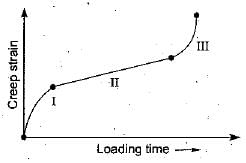Test: Mechanical Properties - 3 - Mechanical Engineering MCQ
20 Questions MCQ Test Topicwise Question Bank for Mechanical Engineering - Test: Mechanical Properties - 3
Brittle fracture is more dangerous than ductile fracture because
Failure due to excessive deformation is controlled by
| 1 Crore+ students have signed up on EduRev. Have you? Download the App |
Fatigue strength for non-ferrous materials is defined at X stress cycles. The value of X is
The destruction of the metal under the fatigue and corrosion is called
Consider the following effects of yield point:
1. Luders bands
2. Strain ageing
3. Blue brittleness
4. Orange peel effect
Q. Which of the above are true?
The yield strength σy Internal frictional stress σi and diameters of grain d are related as
Brinell hardness number is expressed by the equation
where, L = Load in kg
D = Dia of. ball in mm
d = dia of indentation in mm
The property of material which enables it to retain the deformation permanently is called
A material to be rolled or beaten into thin sheets have this property
Which one of the following metal would work- harden more quickly than the others
Material exhibiting time bound behaviour are known as
The material property which depends only on the basic crystal structure is
Match List-I with List-ll and select the correct answer using the codes given below the lists:
List-I
A. Malleability
B. Hardness
C. Resilience
D. Plasticity
List-ll
1. Absorb energy elastically
2. Resistance against deformation
3. Making sheets
4. Permanent deformation
Codes:
A B C D
(a) 3 4 2 1
(b) 4 3 1 2
(c) 1 2 3 4
(d) 3 2 1 4
Among the following material properties at room temperature
P. Ductility
Q. Modulus of Elasticity
R. Hardness
S. Thermal conductivity
Q. Microstructure sensitive properties are:
|
45 videos|314 tests
|
|
45 videos|314 tests
|


















